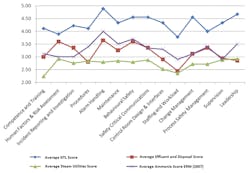A process safety culture should be embedded in every company, yet this isn’t always true, even for leaders of organizations who believe their emphasis on safety resonates throughout their workforce. If the actual results of an assessment of process safety culture maturity at a specialty gas company are any indication, executives and supervisors may want to review their policies and procedures to see if they, too, have areas that must be addressed. In fact, this caveat may well apply throughout the petrochemical industry.
Specialty gas facilities may appear to have an effective process safety management system, however, observational audits conducted in the U.S. and other countries indicate that employees often fail to display correct process safety behaviors when operating equipment. In some instances, employees neglect to maintain equipment, work without adhering to operating procedures or are provided with inadequate operator training. The audits indicate that active employee participation and management commitment were inadequate in selected plants, and methods need to be found to improve process safety culture, particularly the element of human factors.
Process safety culture and human factors
Various process safety culture models address leadership maturity, safety and business management systems. Several describe various behaviors related to an organization’s workforce as a function of safety performance. Others describe five safety maturity levels ranging from emerging to continually improving the safety management system. The Eames and Brightling model (2012) emphasizes five incident reporting and organizational safety learning maturity stages while a business excellence model provides enablers for how process safety should be embedded and sustained to deliver results. Leadership development and employee emotional maturity are a central theme to maturity assessment.
Experience while implementing process safety management systems during 2007–2017 using methodology derived from the Center for Chemical Process Safety (CCPS) indicated that employees feel burdened with process safety because they perceive it as extra work. CCPS noted inadequate implementation of process hazard analysis, maintenance integrity, standard operating procedures and revised process safety information. Results from human factors interviews identified high- and medium-level risks, which include maintenance and integrity of safety critical equipment (labeling, critical operations and use of procedures) in addition to incident reporting and organizational learning. A European health safety study in 2009 attributed 90 percent of accidents to some degree of human failure and that major accident prevention depends on human reliability.
A study of human factors and integration with process safety culture maturity identified maturity states for various specialty gas plant sections, specifically steam utilities, effluent and disposal, ammonia and gas-to-liquid plants. Human factors interviews addressed process safety requirements for the petrochemical sector in addition to completing a human factors survey. A multidisciplined team for each department completed the human factors survey with interviews structured to identify key risks and continuous improvement areas. The evaluation also included team leadership behaviors, hydrocarbon leak rates and site audit findings and implementation progress to assess various process safety culture maturity frameworks.
Incident analysis in two separate studies in the petrochemical sector attributed 20 percent of all incidents to human factors deficiencies. Largest proportions of organizational and human failures were related to storage tanks, piping systems and process vessel accidents. Organizational failures contributed to 69 percent of all storage tank failures related to poor planning and lack of analysis, with more than 30 percent of human failures caused by misjudgement and failure to follow procedures. Organizational failures accounted for some of piping system accidents arising from contractor mismanagement, work permit violations and ineffective management systems. Human factor errors included inadequate checklists and procedures, misjudgement and failing to follow procedures.
Process vessel accidents ranked among the highest organizational failures due to inadequate checklists and procedures and lack of analysis with 17 percent of human failures attributed to procedural violations.
Statistics such as these make a multidimensional approach based on human factors critical.
A specialty gas company and its process safety culture maturity
The following case study used results from interviews and a survey in addition to reviewing facility process safety audits based on U.S. Occupational Safety and Health Administration (OSHA) requirements.
A specialty gas company that has 1,100 full-time employees and 1,000 subcontractors and provides gas-to-liquid, ammonia, steam utilities and effluent waste disposal processing agreed to the evaluation of its process safety culture maturity. Its process safety management had begun implementation several years ago, following reports of incidents elsewhere in the global petrochemical sector that resulted in fires, explosions and toxic releases.
The assessment used human factors dimensions related to man-machine, employee job roles and organizational culture interfaces. The research construct used a process safety culture assessment toolkit, perception survey and interviews and hydrocarbon leak incident history. Audit results assessed implementation effectiveness of process safety management systems.
The interview questions were customized for the petrochemical sector and derived from a human factors inspector’s toolkit. A team of safety psychologists, engineers and teams from maintenance, reliability, project and operations teams for downstream petrochemical businesses developed the specific questionnaire. Multidisciplined staff members for steam and utilities, effluent treatment, gas-to-liquids, and ammonia plants conducted the interviews. Results of the human factors interviews were analyzed for developing an analysis aimed at identifying key human factors process safety management risks (see Figure 1).
Figure 1. Human factors risk summary. Level ratings: 1— major; 2 — medium; 3 —low. All figures/tables courtesy of Niresh Behari
Analyzing human factors
A human factors survey developed provides semiquantitative assessment of human factors. Respondents were asked to rank each dimension using a five-point scale, ranging from 1 (reflecting underdeveloped approaches to human factor issues) to 5 (high-performance on human factors). The perception evaluation process followed by interviews attempted to provide deeper understanding of this assessment to clarify points and any differences in perception. The scoring highlights how human factors were perceived and experienced by individuals across different functions and organizational layers. Survey respondents included maintenance staff, production and engineering supervisors, frontline staff and control room operator staff. Survey results in Figure 2 provide a broad overview of the current human factors on site and identify areas that would benefit from further improvement.
A score of less than 3.5 indicates room for improvement; a score ranging from 4.5 to 5 indicates optimistic perceptions. Gas-to-liquid employees are highly motivated toward living the value of safety. Steam utilities employees have the lowest scores due to organizational restructuring, employee demotivation and ineffective process safety leadership. Similar trend patterns occur at the ammonia plant. Upward (positive perception) trends are noticeable for human factors-related risk assessments, alarm handling, behavioral safety and change management. The opposite (downward trends) exist for competence and training, procedures, maintenance, safety critical communication, control room design, safety interfaces and staffing and workload. The downward trends appear for fatigue risks, managing procedures for critical operations and competence and maintenance of safety critical equipment.
A process safety lagging indicator used in the energy industry is hydrocarbon leak quantification, which measures leak quantity, incident severity, cause and consequence. It considers criteria that would make the incident more severe and adds these up in a weighted fashion to get a severity score for that incident. These include the actual and potential consequences of the incident, the hazardous nature of the chemicals involved and whether protective controls failed.
Steam utilities recorded two incidents of oil spillage and fire with minor and moderate incident classifications, while the ammonia plant experienced three minor incidents due to ammonia and natural gas releases.
Figure 2. Consolidated human factors perception survey results
Assessing leadership behaviors
An independent organization conducted a team leadership survey that assessed leadership blind spots and their contribution toward human factors concerns and safety culture maturity.
Leadership behaviors that hindered process safety maturity included unwillingness to accept accountability, employee blame, fear and lack of trust. The case study identified high-level human factors risks among the additional resources required to update operating procedures, competence of critical staff and ineffective safety communication that have created process safety incidents. The study contained four process safety maturity models based on commitment toward continuous improvement; incident reporting effectiveness and examining interdependent team leadership behaviors through process safety balance scorecard metrics. Process safety maturity levels in decreasing order were gas-to-liquid, ammonia, effluent and disposal, and steam utilities plants.
Lessons learned
The human factors interviews identified high-level risks regarding safety critical equipment labeling, critical operations and competence using standard operating procedures, and the need for organizational learning and communication of incidents. The human factors perception survey supports the findings of the key risks related to maintenance management of critical equipment using procedures and workload planning. Dedicated resources required for compiling SOPs and employee on-the-job training as additional layers of protection should not be compromised. Process safety leadership is required for frequent reporting of low-severity hydrocarbon leaks.
Absence of positive societal leadership behaviors driven by organizational self-esteem suggest resistance against external stakeholders process safety decision-making; e.g., team work with contractors, acceptance of external process safety auditor findings and addressing regulatory compliance. An internal customer delivery mindset discourages active external stakeholder engagement thus suggesting need for changes to organizational values.
A customized human factors checklist and survey identified high and medium risks for process safety related to maintenance integrity, critical equipment labeling, critical operations using procedures and incident reporting. These risks can be minimized by using mitigating and corrective control measures.
Some of the critical success factors that can accelerate process safety maturity are organizational learning and continuous improvement supported by interdependent team leadership behaviors. Each plant had a common set of potential limiting factors related to blame — fear, silo mentality, excessive management control, image concerns and discrimination — all of which undermine leadership development and safety maturity.
Recommendations for fast-tracking process safety maturity in this plant and others like it include conducting ergonomic studies for handling equipment and managing maintenance priorities on critical equipment. Regular employee testing on operating procedures for critical operations should be required in addition to ensuring that actions for all plants are identified and implemented whenever hydrocarbon leaks occur.
Niresh Behari is a process safety engineer in the petrochemical and explosives sectors. For more than 20 years, he has developed, implemented and managed safety management systems for Fortune 500 companies for compliance with OSHA’s Process Safety Management Standard and the EPA’s Risk Management Plan Rule. For more information, email [email protected].



